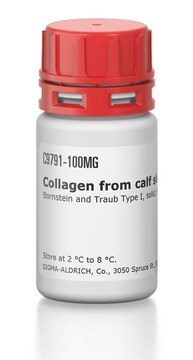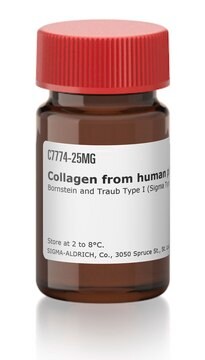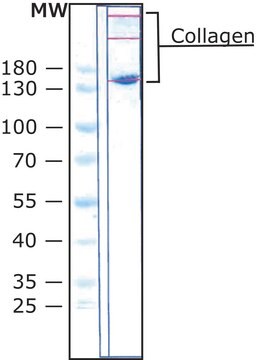C9879
Bovine Collagen Type I
from bovine achilles tendon, powder, suitable for substrate for collagenase
Synonym(s):
Collagen powder
About This Item
Recommended Products
product name
Collagen from bovine achilles tendon, powder, suitable for substrate for collagenase
biological source
bovine Achilles tendon
Quality Level
form
powder
technique(s)
ELISA: suitable
activity assay: suitable
suitability
suitable for substrate for collagenase
UniProt accession no.
storage temp.
2-8°C
Looking for similar products? Visit Product Comparison Guide
General description
Application
- the detection of collagenase activity
- as a reference sample in the thermal analysis study of human bone using differential scanning calorimetry, thermogravimetry, gas chromatography and Fourier transform infrared spectroscopy
- as a substrate for developing a simple assay for determining collagen degradation in vitro
- a study to examine the binding activity of the integral glycoprotein dipeptidyl peptidase IV to insoluble type I collagen by solid-phase enzyme-linked immunosorbent assay
Biochem/physiol Actions
Preparation Note
Reconstitution
Storage Class Code
11 - Combustible Solids
WGK
WGK 1
Flash Point(F)
Not applicable
Flash Point(C)
Not applicable
Personal Protective Equipment
Certificates of Analysis (COA)
Search for Certificates of Analysis (COA) by entering the products Lot/Batch Number. Lot and Batch Numbers can be found on a product’s label following the words ‘Lot’ or ‘Batch’.
Already Own This Product?
Find documentation for the products that you have recently purchased in the Document Library.
Customers Also Viewed
Our team of scientists has experience in all areas of research including Life Science, Material Science, Chemical Synthesis, Chromatography, Analytical and many others.
Contact Technical Service









